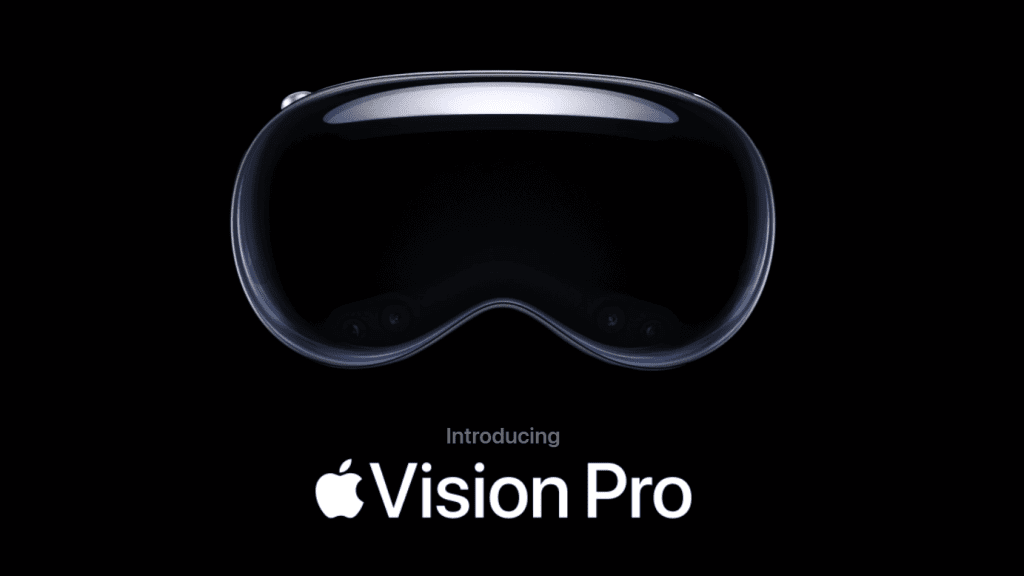 Source: Apple Inc.
Source: Apple Inc. With his turtlenecks and unblinking stare, Steve Jobs was the visionary of Apple. The fans have been living in old-time glory, feeling that Tim Cook has shoes too big to fill. That is until now. Introducing Apple Vision Pro: The Next Evolution in Mixed Reality.
- Apple announces its upcoming mixed-reality headset, the Apple Vision Pro, at the 2023 Worldwide Developers Conference (WWDC).
- The headset will be available for purchase in early 2024 at a price of $3,499, marking Apple’s first major release since the Apple Watch in 2015.
First, it was the Macintosh, then the iMac, the iPod, the iPhone, the iPad, the AirPods, and now the Apple Vision Pro. On June 5th, 2023, Apple announced its upcoming mixed-reality headset at the 2023 Worldwide Developers Conference (WWDC), available for purchase in early 2024 for a whopping $3,499. This release marks the first for Apple in almost a decade: Their last one was for the Apple Watch back in 2015. It feels like a lifetime ago.
The Hardware Speaks for Itself
Apple is known for sleek and futuristic hardware. And the Apple Vision Pro is no different featuring a laminated glass display front, an aluminum frame, and a flexible cushion. The headset incorporates several components to enhance user interaction:
- Five sensors
- Six microphones
- 12 cameras within the frame
- Two micro-OLED 23-megapixel resolution displays
- A nifty iris scanner, the Optic ID, coupled with LEDs and an infrared camera for tracking the user’s eyes.
This might sound crazy, but it reminded me of that autorefractor test at the optometrist. The one with a hot air balloon at the end of a road? No? Just me? Okay then, moving on.
Speaking of eyesight, great news: the device supports custom optical inserts that magnetically attach to the main lens. And to tie the senses into one experience, there is a speaker positioned within the headband, directly over the user’s ears, providing an immersive surround sound experience.
That Sounds like a Tall Order
Fear not, the innovative device relies on the Apple M2 processor and a new Apple R1 sensor input processor. And like any other electronic device, it has a cooling system including a gentle fan. The compromise between a bulky “burden” and a forward-thinking device is a custom-made 2-hour packet battery connected to the device via a cable.
There are other features:
- Digital Crown: moves you from AR to VR
- The, quite honestly, weird outward-facing display, EyeSight, generates a realistic avatar of the user’s face, reflecting the user’s level of immersion.
Introducing visionOS
For this first-generation device’s operating system, visionOS, Apple drew the foundations from iOS core frameworks and incorporated XR-specific frameworks for foveated rendering and real-time interaction. The user can navigate the unique 3D user interface through finger tracking, eye tracking, and speech recognition. Users can also interact with elements by simply looking at them and pinching two fingers together to click, move elements by manipulating their pinched fingers, scroll by flicking their wrist, and highlight text boxes using their eyes and voice commands for input.
visionOS also supports floating windows for apps and is compatible with external Bluetooth peripherals such as the Magic Keyboard, Magic Trackpad, and gamepads. The developers also seamlessly integrated Siri into the system. During the WWDC presentation, they showcased apps from Microsoft 365, Adobe Lightroom, etc.
Hasn’t Mixed Reality Gone Out of Style?
Tsk. Tsk. Apple doesn’t jump on trends: it sets the trends. Expensive ones, but trends, nonetheless. And this has been in the making for years as with every update they were testing little features that came together for this groundbreaking product. This is not a run-of-the-mill mixed-reality headset, it’s in a league of its own.
Inside Telecom provides you with an extensive list of content covering all aspects of the tech industry. Keep an eye on our Tech sections to stay informed and up-to-date with our daily articles.